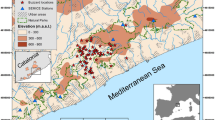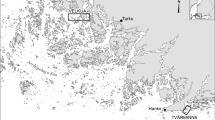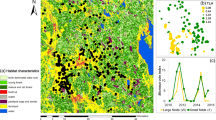Abstract
Distinct numerical responses of predators to fluctuations in the abundance of their prey are often observed in northern regions but occur more rarely in temperate latitudes. This statement is, however, mostly based on observations of breeding populations, while in some predators, for example in raptors, numerous non-breeding floaters can occur. I estimated the breeding density and reproductive performance (nest survey) as well as the density of entire population (transects with distance sampling) of the common buzzard Buteo buteo in western Poland (52°N) in the years 2005–2014 to test the hypotheses that in temperate latitudes: (1) the breeding population of these birds does not show any numerical response, understood as annual changes in their abundance; (2) its reproductive success, however, changes with the abundance of main prey, the common vole Microtus arvalis; and (3) hence the entire buzzard population (including potential immature floaters) present in a given area during the nesting period responds numerically with some time delay. The reproductive success of buzzards was positively correlated with their prey abundance. Contrary to my predictions, however, the breeding population of buzzards showed a slight numerical response with a 3-year lag and the entire population tracked vole fluctuations without any time delay. The immediate numerical response of the entire buzzard population was probably caused by large-scale movements of floaters. Such rapid numerical responses of some predators may contribute to the relative stability of prey populations in temperate latitudes compared to northern regions.



Similar content being viewed by others
References
Angelstam P, Lindström E, Widén P (1984) Role of predation in short-term population fluctuations of some birds and mammals in Fennoscandia. Oecologia 62:199–208
Angerbjörn A, Tannerfeldt M, Erlinge S (1999) Predator–prey relationships: arctic foxes and lemmings. J Anim Ecol 68:34–49
Bednorz J, Kupczyk M, Kuźniak S, Winiecki A (2000) Ptaki Wielkopolski. Monografia faunistyczna. Bogucki Wyd. Nauk., Poznań (in Polish with English summary)
Buckland ST, Anderson DR, Burnham KP, Laake JL (1993) Distance sampling: estimating abundance of biological populations. Chapman and Hall, London
Davis PE, Davis JE (1992) Dispersal and age of first breeding of buzzards in Central Wales. Br Birds 85:578–587
Goszczyński J (1997) Density and productivity of common buzzard Buteo buteo and goshawk Accipiter gentilis populations in Rogów, Central Poland. Acta Ornithol 32:149–155
Goszczyński J, Piłatowski T (1986) Diet of common buzzards (Buteo buteo L.) and goshawks (Accipiter gentilis L.) in the nesting period. Ekologia Polska 34:655–667
Hanski I, Hansson L, Henttonen H (1991) Specialist predators, generalist predators, and the microtine rodent cycle. J Anim Ecol 60:353–367
Hanski I, Henttonen H, Korpimäki E, Oksanen L, Turchin P (2001) Small-rodent dynamics and predation. Ecology 82:1505–1520
Jędrzejewska B, Jędrzejewski W (1998) Predation in vertebrate communities. The Białowieża Forest as a case study. Springer, Berlin
Jędrzejewski W, Szymura A, Jędrzejewska B (1994) Reproduction and food of the buzzard Buteo buteo in relation to the abundance of rodents and birds in Białowieża National Park, Poland. Ethol Ecol Evol 6:179–190
Kenward RE, Walls SS, Hodder KH, Pahkala M, Freeman SN, Simpson VR (2000) The prevalence of non-breeders in raptor populations: evidence from rings, radio-tags and transect surveys. Oikos 91:271–279
Kenward RE, Walls SS, Hodder KH (2001) Life path analysis: scaling indicates priming effects of social and habitat factors on dispersal distances. J Anim Ecol 70:1–13
Korpimäki E (1985) Rapid tracking of microtine populations by their avian predators: possible evidence for stabilizing predation. Oikos 45:281–284
Korpimäki E (1986) Gradients in population fluctuations of Tengmalm’s owl Aegolius funereus in Europe. Oecologia 69:195–201
Korpimäki E (1994) Rapid or delayed tracking of multi-annual vole cycles by avian predators? J Anim Ecol 63:619–628
Korpimäki E, Norrdahl K (1991) Numerical and functional responses of kestrels, short-eared owls, and long-eared owls to vole densities. Ecology 72:814–826
Korpimäki E, Norrdahl K, Rinta-Jaskari T (1991) Responses of stoats and least weasels to fluctuating food abundance: is the low phase of the vole cycle due to mustelid predation? Oecologia 88:552–561
Korpimäki E, Oksanen L, Oksanen T, Klemola T, Norrdahl K, Banks PB (2005) Vole cycles and predation in temperate and boreal zones of Europe. J Anim Ecol 74:1150–1159
Kostrzewa A, Kostrzewa R (1990) The relationship of spring and summer weather with density and breeding performance of the buzzard Buteo buteo, goshawk Accipiter gentilis and kestrel Falco tinnunculus. Ibis 132:550–559
Krüger O (2004) The importance of competition, food, habitat, weather and phenotype for the reproduction of buzzard Buteo buteo. Bird Study 51:125–132
Mackin-Rogalska R, Adamczewska-Andrzejewska K, Nabagło L (1986) Common vole numbers in relation to the utilization of burrow systems. Acta Theriol 31:17–44
Mebs T (1964) Zur Biologie und Populationsdynamik des Mäusebussards (Buteo buteo). J Ornithol 105:247–306 (in German with English abstract)
Millon A, Bretagnolle V (2008) Predator population dynamics under a cyclic prey regime: numerical responses, demographic parameters and growth rates. Oikos 117:1500–1510
Newton I (1979) Population ecology of raptors. Poyser, Berkhamsted
Nielsen ÓK (1999) Gyrfalcon predation on ptarmigan: numerical and functional responses. J Anim Ecol 68:1034–1050
O’Donoghue M, Boutin S, Krebs CJ, Hofer EJ (1997) Numerical responses of coyotes and lynx to the snowshoe hare cycle. Oikos 80:150–162
Panek M, Hušek J (2014) The effect of oilseed rape occurrence on main prey abundance and breeding success of the common buzzard Buteo buteo. Bird Study 61:457–464
Penteriani V, Ferrer M, Delgado MM (2011) Floater strategies and dynamics in birds, and their importance in conservation biology: towards an understanding of nonbreeders in avian populations. Anim Conserv 14:233–241
Reif V, Jungell S, Korpimäki E, Tornberg R, Mykrä S (2004) Numerical response of common buzzards and predation rate of main and alternative prey under fluctuating food conditions. Ann Zool Fenn 41:599–607
Rohner C (1996) The numerical response of great horned owls to the snowshoe hare cycle: consequences of non-territorial ‘floaters’ on demography. J Anim Ecol 65:359–370
Ryszkowski L (1982) Structure and function of the mammal community in an agricultural landscape. Acta Zoologica Fennica 169:45–59
Salamolard M, Butet A, Leroux A, Bretagnolle V (2000) Responses of an avian predator to variations in prey density at a temperate latitude. Ecology 81:2428–2441
Schindler S, Hohmann U, Probst R, Nemeschkal H-L, Spitzer G (2012) Territoriality and habitat use of common buzzards (Buteo buteo) during late autumn in northern Germany. J Raptor Res 46:149–157
Selås V (2001) Breeding density and brood size of common buzzard Buteo buteo in relation to snow cover in spring. Ardea 89:471–479
Sim IMW, Cross AV, Lamacraft DL, Pain DJ (2001) Correlates of common buzzard Buteo buteo density and breeding success in the West Midlands. Bird Study 48:317–329
Solomon ME (1949) The natural control of animal populations. J Anim Ecol 18:1–35
Šotnár K, Obuch J (2009) Feeding ecology of a nesting population of the common buzzard (Buteo buteo) in the Upper Nitra Region, Central Slovakia. Slovak Raptor J 3:13–20
Thomas L, Laake JL, Rexstad E, Strindberg S, Marques FFC, Buckland ST, Borchers DL, Anderson DR, Burnham KP, Burt ML, Hedley SL, Pollard JH, Bishop JRB, Marques TA (2009) Distance 6.0. Release 2. Research Unit for Wildlife Population Assessment, University of St. Andrews, UK. http://www.ruwpa.st-and.ac.uk/distance. Accessed 4 July 2013
Tornberg R, Korpimäki E, Jungell S, Reif V (2005) Delayed numerical response of goshawks to population fluctuations of forest grouse. Oikos 111:408–415
Turchin P, Hanski I (1997) An empirically based model for latitudinal gradient in vole population dynamics. Am Nat 149:842–874
Walls SS, Kenward RE (1998) Movements of radio tagged buzzards Buteo buteo in early life. Ibis 140:561–568
Weir D, Picozzi N (1975) Aspects of social behaviour in the buzzard. Br Birds 68:125–141
Acknowledgements
I am grateful to my colleagues from the Research Station PHA in Czempiń for their help in data collection, and to Javier Balbontín, Robert Kamieniarz, Hannu Pietiäinen and anonymous reviewer for their valuable comments to the manuscript. I also thank Ian Hatcher for language improvements.
Author information
Authors and Affiliations
Corresponding author
Ethics declarations
Conflict of interest
The author declares that he has no conflict of interest.
Rights and permissions
About this article
Cite this article
Panek, M. Numerical responses of an avian predator to prey fluctuations in a temperate latitude: breeders vs. entire population. Popul Ecol 58, 549–555 (2016). https://doi.org/10.1007/s10144-016-0563-0
Received:
Accepted:
Published:
Issue Date:
DOI: https://doi.org/10.1007/s10144-016-0563-0




